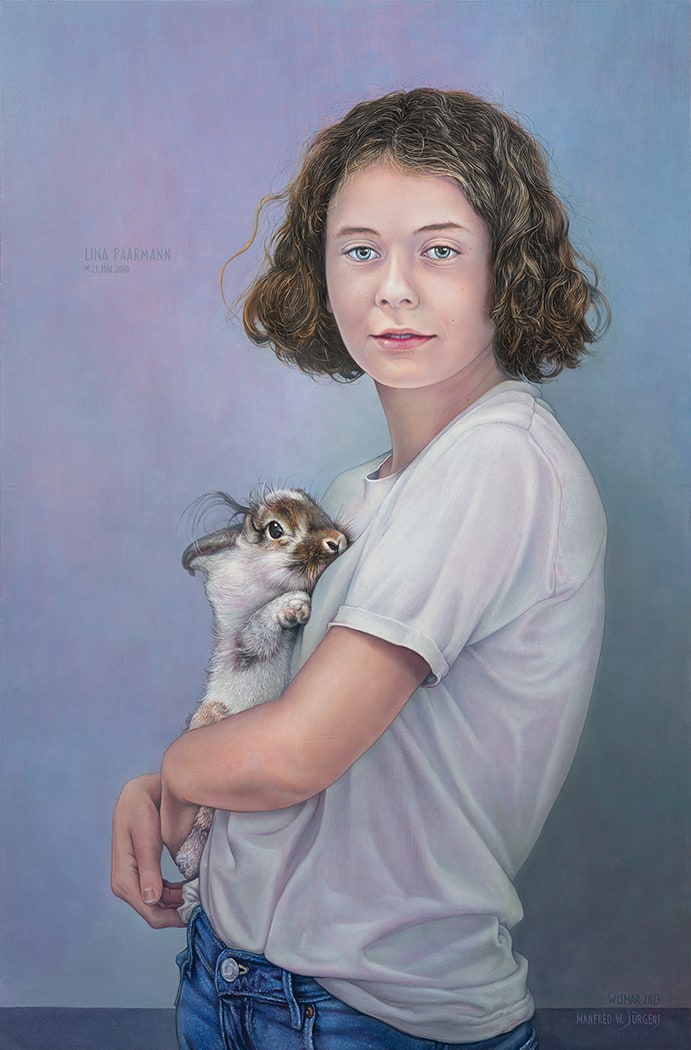One of Germany's two million European hare lives in our street. He has his form in the garden in front of our house. It was about time I painted a portrait of him.
We have known each other for two years. The first time I saw him together with his mother, eating lunch in our garden. Days later, he was sitting alone by the hedge bordering our neighbours' property. I slowly approached him and observed the tiny creature, just 15 cm long, up close. "Hey," I said, "then we'll be seeing each other more often in the future, because hares like you can live up to 12 years and inhabit a fairly small territory. Watch out that the corvids don't get you. You don't need to be afraid of me; I'm a vegetarian too."
Now we examined each other at eye level. Only after a few minutes did he slowly walk away. In Brockhaus' Encyclopedia from 1884, I read, "His great timidity, which has become proverbial, never allows him to give himself over to complete carelessness."
Hares are born with fur. Rabbits are born naked. Even as adults, they are only half the size of a hare in length and weight. Unlike their counterparts in the field, rabbits live in self-dug underground burrows.
My childhood bedroom was adorned with an art print of the Nuremberg hare. I had cut it out of a small book by Dürer.
To supplement his disability pension, my father kept domestic rabbits. After school, I often went to meadows and field edges to pick dandelions and then dreamily feed the approximately 70 rabbits. The Sunday rabbit roast was delicious. I often fell silent, thinking of the animals' tragic end: Father skinning them, tanning their fur, and selling it to his fur trader for 15 marks each.
In our neighbourhood today, the European hare is very popular. ❯ Lina named him "Goethe" because he lives in the Goethe Street. If he lived in the Coffin Maker's Street, he would be called Coffin Maker.
named him "Goethe" because he lives in the Goethe Street. If he lived in the Coffin Maker's Street, he would be called Coffin Maker.
Goethe grew up and now sat in the garden in front of our house. Outside of mating season, he is a solitary animal. Through my studio window, we could observe each other for a few hours each day. He chose this safe haven as his form. Wildflowers and clover were plentiful. Everything is organic.
When he saw me in the garden, he initially ran away. So, each day, I cautiously approached him a little closer. Only when I got down on all fours and approached him at hare height did he sit there curiously. We had to earn this trust. Goethe allowed me to observe him from a distance of one and a half meters. Over time, I took hundreds of photographic sketches of him. I even managed to get some video footage on a small tripod. If only I knew what he gleaned about me through his amber eyes. Tourists strolling by saw me, a four-legged creature crawling through the wild garden, shook their heads in disbelief. Meanwhile, Goethe sat unseen in his depression from the sidewalk.
When I began my portrait of the hare, our plumber remarked, "If the boss, your colleague Dürer, sees this, he'll throw stones at you from his cloud."
Watch a short film about Goethe below (in German).
Text © MWJ, Wismar 11/2025
Image above © Painting by MWJ · Goethe the Hare, 2025
Glazing technique on canvas, mounted on wood, 55 x 45 cm